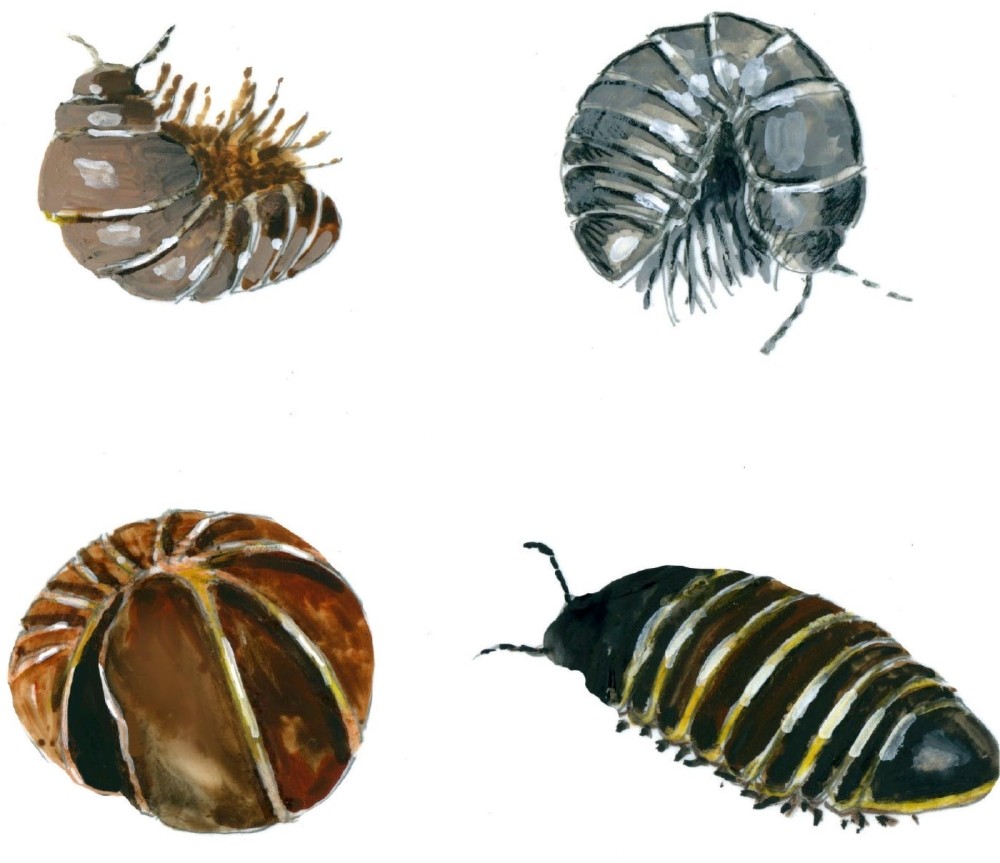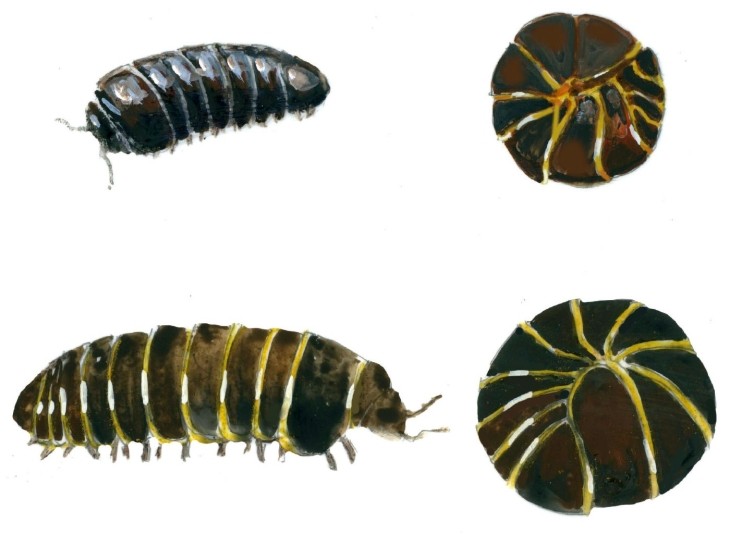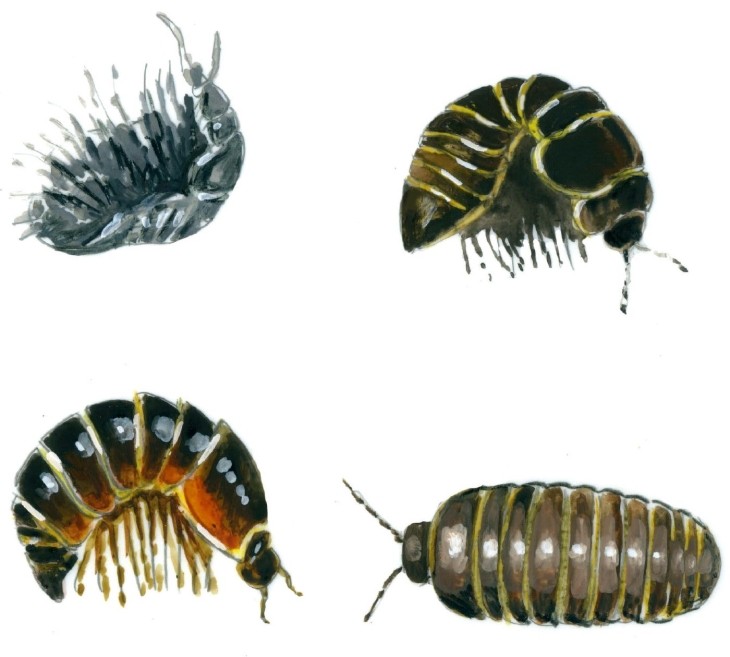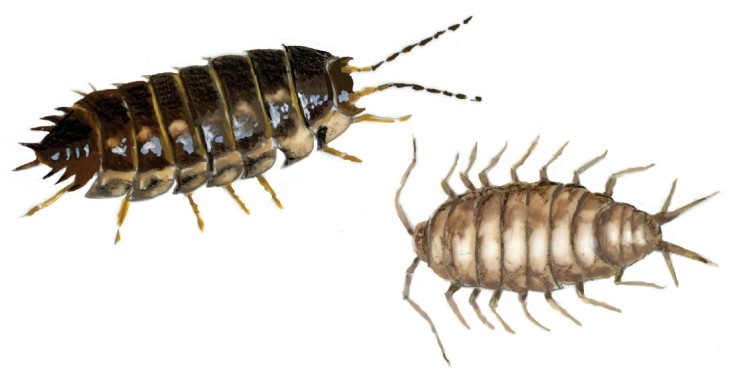
If you look beneath the damp undersides of cardboard and other packing materials, you’re likely to find tiny creatures that typically hide under fallen leaves and rotting wood, where they’re much harder to observe. Common among these invertebrates are what we often call “pill bugs,” “sow bugs,” or “wood lice.” Despite these names, they aren’t insects at all but crustaceans, more properly called “isopods.”
Isopods (Latin for “equal foot”) are so named because all 14 of their legs are nearly identical. Most species are dark gray to brown, slightly flattened top to bottom, with two pairs of antennae at the front end. Their body shape is oval.
The head-like front segment, called the cephalothorax, and the next seven segments to which paired legs are attached make up the “pereon.” This arrangement is similar to an insect’s head and thorax except that insects have just three thoracic segments accounting for their six legs. Bringing up the rear are six more segments, the “pleon,” which are analogous to an insect’s abdomen.
Two common isopod types are readily distinguished. The pill bug or roly-poly type can roll into a protective ball when threatened. Common species appear glossy. Sow bugs lack ball-rolling superpowers, and have a visible pair of tail-like structures called uropods. (Pill bugs also have uropods but they’re concealed when viewed from above.)
In common with earwigs, earthworms, and assorted invertebrates, many of these species are not native and came to North America in soil that was used as ship ballast. Ballast loaded in places such as Amsterdam, and unloaded in early American ports such as Boston, liberated most of the soil fauna of Europe on a new continent.
There’s another marine connection to these creatures. They evolved from saltwater ancestors and you can find their salty cousins by kicking over a pile of washed-up seaweed. Freshwater relatives also inhabit lakes and ponds. However, if you flip a terrestrial isopod over, you’ll find a critical difference: lungs, clearly visible as white patches, that are tucked under the rear segments where the gills used to be. These lungs work best in humid conditions that exist in the leaf litter layer – or under cardboard.
Some basic behaviors keep isopods fed, safe, and in the appropriate environment. They are attracted to moisture: when my Saint Michael’s College students place a dozen isopods in a basin with both moist and dry paper, inevitably, most isopods will wander into the moist portion of the enclosure. The same experiment works well with bright and shaded habitats – isopods favor the dark, which helps them avoid predators.
An exception to this preference is when the aquatic isopod Gammarus lacustris is infected by a parasitic worm (Polymorphus paradoxus). Instead of living safely between rocks and in pond-floor mud, the isopod bravely climbs out onto sunlit rock tops where it is conspicuous to hungry waterfowl. As if its predicament weren’t bad enough, the infected isopod also turns an eye-catching shade of blue. All this serves the parasite well because it must be eaten by a duck to complete its life cycle.
Isopods are easy to overlook, but they’re important participants in the detritus food chain. The isopods in your compost are important agents of change, converting leaves to the crumbly, brown gold that will help your cabbages reach their full potential. They are a sign of healthy, chemical-free soil, and because they mostly eat dead vegetation, they are little threat to your prized hydrangeas or dahlias.
Isopods are unusual among invertebrates in the degree of parental care provided to offspring. Once a female lays eggs, she tucks them into a water-filled pouch called a “marsupium” where moisture and water chemistry are well controlled. When the eggs hatch, the early-stage offspring remain in the marsupium where they are provided with food in the form of their mother’s feces. While this may not appeal to human sensibilities, predigested plant material contains nutrients that get the youngsters off to an excellent start in life.
Like all self-respecting arthropods, isopods shed their exoskeletons to grow but they do so in a distinctive way. Most arthropods split their old exoskeleton along their dorsal surface and crawl out of their old armor in one fell swoop. Isopod exoskeletons split across the width and the isopods wriggle out of the back end first. Perhaps exhausted from that process, they wait a few days before finishing the process by wriggling out the front end.
As a result, you may find what looks like half a dead isopod, or a live one with one end looking pale just after the partial molt. All this is perfectly normal and indicates that they have everything they need in their habitat, whether that’s your compost pile – or the underside of a discarded Amazon box.





Discussion *